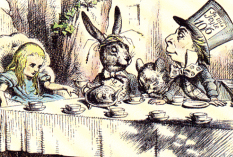Alice in Wonderland

There is a haunting exchange between Tweedledum and Tweedledee and Alice in Lewis Carroll's Through the Looking Glass, the sequel to Alice's Adventures in Wonderland. Tweedledum and Tweedledee tell Alice that she's not real. She replies that that's nonsense, but the twins insist that she, and they, and pretty much everything, are merely the stuff of the White King's dream. Alice says she's not convinced, but she does demand they all be quiet so they don't risk waking the king.
The scene is reminiscent of Chuang Tzu's most famous Taoist story "I Dreamt I Was a Butterfly" (translated here by N.A. Giles):
Once upon a time, I, Chuang Tzu, dreamt I was a butterfly, fluttering hither and thither, to all intents and purposes a butterfly. I was conscious only of following my fancies as a butterfly, and was unconscious of my individuality as a man. Suddenly I awaked, and there I lay, myself again. Now I do not know whether I was then a man dreaming I was a butterfly, or whether I am now a butterfly dreaming I am a man.
Children may find both snippets entertaining, but both strike at some of the deepest metaphysical and epistemological puzzles that have kept philosophers wondering and writing for thousands of years.
This is one of the wonders of both Lewis Carroll's Alice books: they can be read as nonsense, entertainment, psychological analyses, satire, cultural documents, mathematical games, philosophical treatises--all of these approaches work with these richly-textured novels.
The action, talking animals and wordplay are easily accessible by children; they have no difficulty recognizing the puns of the mock turtle: "We learned reeling and writhing" and "We called him tortoise because he taught us." Victorian children would have more readily identified the changes from "How doth the little busy bee" (which they would have had to memorize and recite to relatives in the parlour) to "How doth the little crocodile" (which reflects the violence they probably felt because they had to memorize and recite poems to relatives in the parlour).
Older readers come back to the book and discover more layers of meaning: they see the attack on the ineffectual, unjust aristocracy in the characters of the Duchess (who has a title which grants her a certain amount of power even though she can't control her cook, is abusive with her child, has no original thoughts) and the Queen and King of Hearts (sentencing people to death without trials only to release them all later).
Alice in Wonderland is open to many interpretations, though not all. Looking at the size/shape changes following all the mushroom eating as a sort of mind-altering, psychedelic trip is not especially sensible considering the source: The Jefferson Airplane's "White Rabbit" used images from the novel to suggest drug hallucinations from the 1960's; LSD was nowhere in existence in the 1800's when Carroll wrote his book.
In their anthology Classics of Children's Literature editors Griffith and Frey see the size changes in much broader human terms:
Alice might be seen as moving from a kind of birth trauma--falling down the tunnel, the long low hall, the amniotic pool--through meeting little animals (mouse, rabbit, lizard, caterpiller, pigeon) to meeting larger animals and adult humans. Her adventures intensify in the sense that the Duchess and plight of the baby seem more powerful and threatening than the Caucus Race or Caterpiller, and the tea party picks up the pace of madness while the Queen of Hearts and the Mock-Tutrtle adventures introduce increased fear and nostalgia ("'off with her head,'" songs of voracious shark and panther). Then comes the final trial, a full social event in which Alice reaches the limit of her frustration and anger, asserts herself aggressively, yet wakes to "dead leaves" and "dull reality." Alice is in one sense "socialized" but with decidedly mixed results (just as in Through the Looking Glass she becomes Queen all right yet finds it is not all "feasting and fun").
This same sequence of size changes can also be analyzed as an individual's self-actualization. Readers come back to the book again and again, and it offers new ideas each time.
The book works on so many levels, and it is one of children's literature's most enduring classics.
![[course schedule]](button31s.gif)
![[discussion questions]](button31q.gif)
![[lectures]](button31l.gif)
![[writing assignments]](button31p.gif)
![[readings]](button31r.gif)
![[home]](button31h.gif)